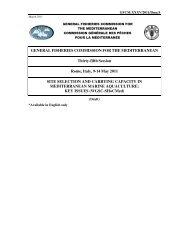Status of alien species in the Mediterranean and Black Sea
Status of alien species in the Mediterranean and Black Sea
Status of alien species in the Mediterranean and Black Sea
Create successful ePaper yourself
Turn your PDF publications into a flip-book with our unique Google optimized e-Paper software.
37<br />
<strong>Mediterranean</strong> <strong>Sea</strong> (Figure 19). Ship transportation is <strong>the</strong> ma<strong>in</strong> vector for <strong>the</strong> <strong>alien</strong> <strong>species</strong> with ballast<br />
tanks <strong>and</strong> hull foul<strong>in</strong>g. Meanwhile, after <strong>the</strong> open<strong>in</strong>g <strong>of</strong> <strong>the</strong> Suez Canal, some <strong>species</strong> pass to <strong>the</strong><br />
Eastern <strong>Mediterranean</strong> <strong>Sea</strong> from <strong>the</strong> Red <strong>Sea</strong>. It is called lessepsian migration (Por, 1978). Some<br />
commercial <strong>species</strong> have been <strong>in</strong>tentionally <strong>in</strong>troduced, like <strong>the</strong> Japanese oyster Crassostera gigas or<br />
<strong>the</strong> venerid Ruditapes philipp<strong>in</strong>arum, which have also been established <strong>in</strong> <strong>the</strong> <strong>Mediterranean</strong> <strong>Sea</strong>.<br />
Accidentally <strong>in</strong>troduced Caulerpa taxifolia has also spread around <strong>the</strong> <strong>Mediterranean</strong>. All <strong>the</strong>se <strong>alien</strong><br />
<strong>species</strong> dispersed over <strong>the</strong> <strong>Mediterranean</strong> have changed mar<strong>in</strong>e biodiversity <strong>and</strong> fisheries <strong>in</strong> this<br />
unique sea.<br />
The present <strong>Mediterranean</strong> fauna <strong>and</strong> flora are a mixture <strong>of</strong> <strong>the</strong> <strong>Mediterranean</strong> <strong>and</strong> Red <strong>Sea</strong> biota<br />
components due to <strong>the</strong> Suez Canal. It is possible to call <strong>the</strong> eastern <strong>Mediterranean</strong> <strong>Sea</strong> a lessepsian<br />
prov<strong>in</strong>ce after this biotic change. Never<strong>the</strong>less, a total <strong>of</strong> 10 000 to 12 000 mar<strong>in</strong>e <strong>species</strong> have been<br />
recorded <strong>in</strong> <strong>the</strong> <strong>Mediterranean</strong> <strong>Sea</strong> <strong>and</strong> this rich biodiversity represents 8–9 percent <strong>of</strong> <strong>the</strong> total number<br />
<strong>species</strong> <strong>in</strong> <strong>the</strong> world’s seas (EEA, 2006). It should be noted that <strong>the</strong> deep sea part <strong>of</strong> <strong>the</strong> <strong>Mediterranean</strong><br />
<strong>Sea</strong> is still poorly studied <strong>and</strong> more potential <strong>species</strong> may be discovered <strong>in</strong> <strong>the</strong> next years if <strong>the</strong><br />
research <strong>in</strong>tensity is <strong>in</strong>creased <strong>in</strong> <strong>the</strong> region, particularly <strong>in</strong> <strong>the</strong> deep bas<strong>in</strong>s.<br />
3.2 Ma<strong>in</strong> vectors for <strong>alien</strong> <strong>species</strong> <strong>in</strong> <strong>the</strong> <strong>Mediterranean</strong> <strong>Sea</strong><br />
The ma<strong>in</strong> vectors for <strong>alien</strong> <strong>species</strong> <strong>in</strong> <strong>the</strong> <strong>Mediterranean</strong> <strong>Sea</strong> can be described as follows:<br />
a) shipp<strong>in</strong>g, ship’s ballast waters, tank sediments, hull foul<strong>in</strong>g, <strong>and</strong> mar<strong>in</strong>e debris;<br />
b) straits: <strong>the</strong> Kerch <strong>and</strong> <strong>the</strong> Turkish Straits System for <strong>the</strong> <strong>Black</strong> <strong>Sea</strong> <strong>species</strong> <strong>and</strong> <strong>the</strong> Gibraltar<br />
Strait for <strong>the</strong> Atlantic <strong>species</strong>. These straits also play an important role for <strong>the</strong> <strong>in</strong>troduction <strong>of</strong><br />
<strong>the</strong> <strong>Black</strong> <strong>Sea</strong> orig<strong>in</strong>ated <strong>alien</strong> <strong>species</strong>, such as Liza haematocheila, Mnemiopsis leidyi <strong>and</strong><br />
Rapana venosa, <strong>and</strong> <strong>the</strong> Atlantic orig<strong>in</strong>ated <strong>alien</strong> <strong>species</strong>, respectively.<br />
c) <strong>the</strong> Suez Canal: one <strong>of</strong> <strong>the</strong> major vectors for <strong>the</strong> Indo-Pacific orig<strong>in</strong>ated <strong>species</strong> or lessepsian<br />
<strong>species</strong>,<br />
d) <strong>in</strong>tentional or un<strong>in</strong>tentional <strong>in</strong>troduction by humans: this <strong>in</strong>troduction is generally for<br />
aquaculture or aquarium; <strong>and</strong><br />
e) besides <strong>the</strong>se ma<strong>in</strong> vectors, aquarium, fish baits <strong>and</strong> o<strong>the</strong>r m<strong>in</strong>or vectors should also be<br />
considered.<br />
Accord<strong>in</strong>g to Streftaris et al. (2005), shipp<strong>in</strong>g, although it contributed more than aquaculture as a<br />
vector, appears to have had a less significant role (20 percent) <strong>in</strong> <strong>the</strong> <strong>Mediterranean</strong> than <strong>the</strong> Suez<br />
Canal (52 percent). Galil (2008a) reported 558 <strong>and</strong> Galil (2009) 573 <strong>species</strong> from <strong>the</strong> <strong>Mediterranean</strong><br />
<strong>Sea</strong>. However, this number was estimated as thous<strong>and</strong>s by Por (2009).
















